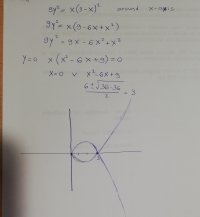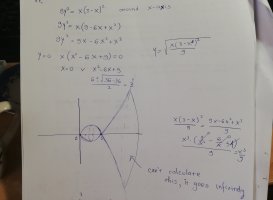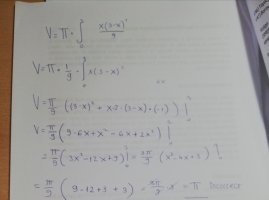You are using an out of date browser. It may not display this or other websites correctly.
You should upgrade or use an alternative browser.
You should upgrade or use an alternative browser.
Graph function
- Thread starter Loki123
- Start date
Forgot to mention around x axis part. I am supposed to calculate the volume of the figure the curve makes by rotating around x axis. Sorry!I would have never known how to graph this had I not looked it up in one of those "graph a function" websites. How can I know how to graph it without a website? View attachment 32378
Steven G
Elite Member
- Joined
- Dec 30, 2014
- Messages
- 14,383
Why would you multiply out (3-x)^2 to find its roots? Isn't the root clearly x=3?
Of course that volume would be infinity!
Why are you trying to compute the integral from x=0 to x=3? Is it because you were asked to or because going from 0 to oo gives the answer as oo?
Why are taking the derivative of x(3-x)^2/9 when you are asked to compute the derivative?
Why are integrating \(\displaystyle \dfrac{\pi}{9}\int x(3-x)^2\) and not \(\displaystyle \dfrac{\pi}{9}\int x(3-x)^2dx\)?
Of course that volume would be infinity!
Why are you trying to compute the integral from x=0 to x=3? Is it because you were asked to or because going from 0 to oo gives the answer as oo?
Why are taking the derivative of x(3-x)^2/9 when you are asked to compute the derivative?
Why are integrating \(\displaystyle \dfrac{\pi}{9}\int x(3-x)^2\) and not \(\displaystyle \dfrac{\pi}{9}\int x(3-x)^2dx\)?
Last edited:
Why would you multiply out (3-x)^2 to find its roots? Isn't the root clearly x=3?
Steven G
Elite Member
- Joined
- Dec 30, 2014
- Messages
- 14,383
That is not a good method when it comes to math!sometimes i don't think, i just work
It's not insulting. Our class doesn't prioritize sketching graphs like these. We mostly do simple curves and straight lines. Is there any other way than graphing it point by point?I don't mean to be insulting but how can you not know how to graph [imath]gy^2 = x(3 - x)[/imath] by some method if you are in Calculus? At the very least you can make a table and graph it point by point!
-Dan
skeeter
Elite Member
- Joined
- Dec 15, 2005
- Messages
- 3,215
[imath]9y^2 = x(3-x)^2[/imath]I don't mean to be insulting but how can you not know how to graph [imath]gy^2 = x(3 - x)[/imath] by some method if you are in Calculus? At the very least you can make a table and graph it point by point!
-Dan
topsquark
Senior Member
- Joined
- Aug 27, 2012
- Messages
- 2,269
I just saw skeeter's post and realized I had a typo. Yes, that's a tough one. You would have to use a graphing utility or plot point by point.It's not insulting. Our class doesn't prioritize sketching graphs like these. We mostly do simple curves and straight lines. Is there any other way than graphing it point by point?
-Dan
Steven G
Elite Member
- Joined
- Dec 30, 2014
- Messages
- 14,383
Yes, you are not integrating! You are differentiation! Why?
Can we see the exact problem so we know which volume we are looking for. If it is 0 to infinity, then armed with the graph we should know that the volume = infinity. There is no need to calculate this!
Can we see the exact problem so we know which volume we are looking for. If it is 0 to infinity, then armed with the graph we should know that the volume = infinity. There is no need to calculate this!
Steven G
Elite Member
- Joined
- Dec 30, 2014
- Messages
- 14,383
yes, use calculus to graph this curve.It's not insulting. Our class doesn't prioritize sketching graphs like these. We mostly do simple curves and straight lines. Is there any other way than graphing it point by point?
Steven G
Elite Member
- Joined
- Dec 30, 2014
- Messages
- 14,383
Are you way off with the answer being infinity or PI?????what about volume calculations?? what am i missing? i am waaaay off
One problem, one answer!
Somehow I didn't see past the first paragraph the first time. As for the rest, I am not sure. I know the answer isn't infinity, so I just assumed that I do not need to calculate the Infinite part.Why would you multiply out (3-x)^2 to find its roots? Isn't the root clearly x=3?
Of course that volume would be infinity!
Why are you trying to compute the integral from x=0 to x=3? Is it because you were asked to or because going from 0 to oo gives the answer as oo?
Why are taking the derivative of x(3-x)^2/9 when you are asked to compute the derivative?
Why are integrating \(\displaystyle \dfrac{\pi}{9}\int x(3-x)^2\) and not \(\displaystyle \dfrac{\pi}{9}\int x(3-x)^2dx\)?
How?yes, use calculus to graph this curve.
The problem is in #2Yes, you are not integrating! You are differentiation! Why?
Can we see the exact problem so we know which volume we are looking for. If it is 0 to infinity, then armed with the graph we should know that the volume = infinity. There is no need to calculate this!
Steven G
Elite Member
- Joined
- Dec 30, 2014
- Messages
- 14,383
Solve for y. Take derivative, set =0 to get critical point. Take 2nd derivative, set=0 to get possible points of inflection....How?
You know, like you normally curve sketch.
Steven G
Elite Member
- Joined
- Dec 30, 2014
- Messages
- 14,383
If you insist on this, then I can't see how the volume is anything other than infinity. The volume is blowing up as x goes to infinity.The problem is in #2
Why are you integrating from x=0 to x=3. I see where x=0 comes from but have no idea, based on post #2, where you are getting x=3 from?? Can you explain? Possibly posting the exact problem might explain when you are stopping at x=3.
Last edited:
that's the exact problem. if you mean book copy, i do not have it unfortunately.If you insist on this, then I can't see how the volume is anything other than 0. The volume is blowing up as x goes to infinity.
Why are you integrating from x=0 to x=3. I see where x=0 comes from but have no idea, based on post #2, where you are getting x=3 from?? Can you explain? Possibly posting the exact problem might explain when you are stopping at x=3.
as for 3, as far as i know you calculate the volume by Pi * integral of (function of the curve)^2, where integral is defined from the start point on x axis to the end point of the x axis of the curve. I go from 0 to 3 because i don't think they asked for infinity answer and because it's overall a different shape.



